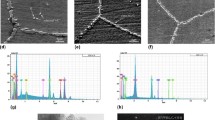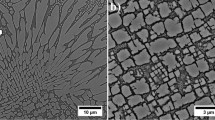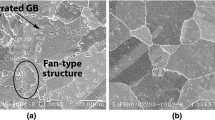Abstract
Formation and growth of secondary γ′ precipitate-free zones (PFZ) in the vicinity of grain boundaries in five Ni-based superalloys have been investigated for different heat treatment times and temperatures. A special focus has been placed on a high carbon containing version of the AD730™ alloy. While the formation of PFZ is induced by the precipitation of Ti-rich secondary carbides during aging in Nimonic PE16, it has been shown in the present study that PFZ mainly form during close-to-γ′-solvus heat treatments and are associated with the nucleation of intergranular γ′ precipitates in the studied alloys. Since these precipitates have chemical compositions similar to intragranular secondary γ′ particles, depletion of precipitate-forming elements leads to the dissolution of intragranular secondary γ′ precipitates near grain boundaries and finally to the formation of PFZ. PFZ width evolutions have been described using a parabolic model, and their kinetics obey an Arrhenius-type law indicating a diffusion-controlled process. Thanks to chemical composition analyzes in and near the PFZ, it is shown that both titanium and niobium diffusion, in volume and through the grain boundaries, could be controlling the PFZ formation.












Similar content being viewed by others
Data and code availability
Data (SEM/TEM micrographs and data tables) and codes (post-treatment files) are available upon request.
References
Reed RC (2006) The superalloys fundamentals. Cambridge University Press
Tabaoda Michel H, Bridier F, Cormier J, et al (2016) Mechanical properties of cast & wrought hybrid disks. In: Proceedings of the 13th international symposium on superalloys. The minerals, metals & materials society, pp 539–548
Mangen W, Nembach E (1989) The effect of grain size on the yield strength of the γ′-hardened superalloy NIMONIC PE16. Acta Metall 37:1451–1463. https://doi.org/10.1016/0001-6160(89)90177-6
Maldonado R, Nembach E (1997) The formation of precipitate free zones and the growth of grain boundary carbides in the nickel-base superalloy NIMONIC PE16. Acta Mater 45:213–224. https://doi.org/10.1016/S1359-6454(96)00139-5
Krol T, Baither D, Nembach E (2004) The formation of precipitate free zones along grain boundaries in a superalloy and the ensuing effects on its plastic deformation. Acta Mater 52:2095–2108. https://doi.org/10.1016/j.actamat.2004.01.011
Laurence A (2016) Impact du sur-vieillissement métallurgique sur le comportement et la durabilité du nouveau superalliage pour disque de turbine René 65. PhD Thesis, Ecole Nationale Supérieure de Mécanique et d’Aérotechnique. https://theses.hal.science/tel-01371652
Mrozowski N (2021) Mécanismes de propagation de fissure dans un superalliage base nickel polycristallin en régime d’interaction fatigue-fluage-oxydation-vieillissement métallurgique. PhD Thesis, Ecole Nationale Supérieure de Mécanique et d’Aérotechnique. https://theses.hal.science/tel-03092324
Billot T (2010) Comportement et endommagement en fatigue et fatigue - fluage à haute température de différents états microstructuraux du superalliage base-nickel Udimet 720. PhD Thesis, Ecole Nationale Supérieure de Mécanique et d’Aérotechnique. https://theses.hal.science/tel-00545922
Krol T, Baither D, Nembach E (2003) Quantification of the detrimental effects of precipitate free zones on the yield strength of a superalloy. Scripta Mater 48:1189–1194. https://doi.org/10.1016/S1359-6462(02)00566-3
Krol T, Baither D, Nembach E (2004) Softening of the superalloy NIMONIC PE16 by precipitate free zones along grain boundaries. Mater Sci Eng, A 387–389:214–217. https://doi.org/10.1016/j.msea.2004.01.075
Baither D, Krol T, Nembach E (2003) In-situ transmission electron microscopy study of dislocation processes at precipitate-free zones in a γ ′-strengthened superalloy. Phil Mag 83:4011–4029. https://doi.org/10.1080/14786430310001603445
Baither D, Krol T, Nembach E (2004) Dislocation processes in precipitate-free zones in NIMONIC PE16 studied by in situ transmission electron microscopy. Mater Sci Eng, A 387–389:163–166. https://doi.org/10.1016/j.msea.2004.01.072
Larrouy B (2014) Mécanismes de déformation et d’amorçage de fissures dans l’alliage UdimetTM 720Li en relation avec les paramètres microstructuraux. PhD Thesis, Ecole Nationale Supérieure de Mécanique et d’Aérotechnique. https://theses.hal.science/tel-01129092
Devaux A, Li W, Crozet C, Lardon JM (2016) Evaluation of AD730TM for high temperature fastener applications. In: Superalloys 2016: proceedings of the 13th international symposium on superalloys. https://doi.org/10.1007/978-3-030-51834-9
Rosenbaum HS, Turnbull D (1958) On the precipitation of silicon out of a supersaturated aluminum-silicon solid solution. Acta Metall 6:653–659. https://doi.org/10.1016/0001-6160(58)90160-3
Rosenbaum HS, Turnbull D (1959) Metallographic Investigation of precipitation of dilicon from aluminum. Acta Metall 7:664–674
Embury JD, Nicholson RB (1965) The nucleation of precipitates: the system Al–Zn–Mg. Acta Metall 13:403–417. https://doi.org/10.1016/0001-6160(65)90067-2
Ryum N (1968) The influence of a precipitate-free zone on the mechanical properties of an Al–Mg–Zn alloy. Acta Metall 16:327–332. https://doi.org/10.1016/0001-6160(68)90018-7
Unwin PNT, Lorimer GH, Nicholson RB (1969) The origin of the grain boundary precipitate free zone. Acta Metall 17:1363–1377. https://doi.org/10.1016/0001-6160(69)90154-0
Abe M, Asano K, Fujiwara A (1973) Influence of the precipitate-free zone width on the tensile properties of an Al-6 Wt pct Zn-1.2 Wt pct Mg alloy. MT 4:1499–1505. https://doi.org/10.1007/BF02668000
Chang S, Morral JE (1975) The influence of the quenching rate on precipitate-free-zones in an Al–Zn–Mg alloy. Acta Metall 23:685–689. https://doi.org/10.1016/0001-6160(75)90050-4
Squires RL, Weiner RT, Phillips M (1963) Grain-boundary denuded zones in a magnesium 1/2 wt% zirconium alloy. J Nucl Mater 8:77–80. https://doi.org/10.1016/0022-3115(63)90010-2
Harris JE, Jones RB (1963) Directional diffusion in magnesium alloys. J Nucl Mater 10:360–362. https://doi.org/10.1016/0022-3115(63)90187-9
Tien JK, Gamble RP (1971) The influence of applied stress and stress sense on grain boundary precipitate morphology in a nickel-base superalloy during creep. MT 2:1663–1667. https://doi.org/10.1007/BF02913891
Gibbons TB (1972) The influence of diffusion creep on precipitate-free zone formation in Ni–20% Cr-base alloys. Metal Sci J 6:13–16. https://doi.org/10.1179/030634572790446172
Wolfenstine J, Ruano OA, Wadsworth J, Sherby OD (1993) Refutation of the relationship between denuded zones and diffusional creep. Scr Metall Mater 29:515–520. https://doi.org/10.1016/0956-716X(93)90157-N
Burton B, Reynolds GL (1995) In defense of diffusional creep. Mater Sci Eng, A 191:135–141. https://doi.org/10.1016/0921-5093(94)09643-0
Ruano OA, Sherby OD, Wadsworth J, Wolfenstine J (1996) Rebuttal to “In defense of diffusional creep.” Mater Sci Eng A 211:66–71. https://doi.org/10.1016/0921-5093(95)10090-3
Ruano OA, Sherby OD, Wadsworth J, Wolfenstine J (1998) Diffusional creep and diffusion-controlled dislocation creep and their relation to denuded zones in Mg-ZrH2 materials. Scripta Mater 38:1307–1314. https://doi.org/10.1016/S1359-6462(98)00021-9
Wadsworth J, Ruano OA, Sherby OD (2002) Denuded zones, diffusional creep, and grain boundary sliding. Metall and Mat Trans A 33:219–229. https://doi.org/10.1007/s11661-002-0084-7
Jensrud O, Ryum N (1984) The development of microstructures in AI-Li alloys. Mater Sci Eng 64:229–236. https://doi.org/10.1016/0025-5416(84)90106-X
Jha SC, Sanders TH, Dayananda MA (1987) Grain boundary precipitate free zones in Al-Li alloys. Acta Metall 35:473–482. https://doi.org/10.1016/0001-6160(87)90253-7
Yao DP, Zhang YZ, Hu ZQ et al (1989) The formation and growth of PFZ at grain boundaries in Al-11.9at%Li alloy. Scr Metall 23:537–541. https://doi.org/10.1016/0036-9748(89)90447-X
Wen H, Zhao B, Dong X et al (2020) A systematic investigation of precipitates in matrix and at grain boundaries in an alumina-forming austenitic steel during creep testing at 700 °C. Metall Mater Trans A 51:4186–4194. https://doi.org/10.1007/s11661-020-05848-4
Peterson A, Baker I (2021) The formation mechanism, growth, and effect on the mechanical properties of precipitate free zones in the alumina-forming austenitic stainless steel Fe–20Cr–30Ni–2Nb–5Al during creep. Mater Sci Eng A 820:141561. https://doi.org/10.1016/j.msea.2021.141561
Alvarado K, Janeiro I, Florez S et al (2021) Dissolution of the Primary γ′ Precipitates and Grain Growth during Solution Treatment of Three Nickel Base Superalloys. Metals 11:1921. https://doi.org/10.3390/met11121921
Govaere A (2020) Impact des carbures sur la variabilité des propriétés en fatigue de superalliages pour disques. PhD Thesis, ISAE-ENSMA Ecole Nationale Supérieure de Mécanique et d’Aérotechique. https://tel.archives-ouvertes.fr/tel-03232119
Devaux A, Picque B, Gervais M, et al (2012) AD730TM - A New Nickel-based Superalloy for High Temperature Engine Rotative Parts. In: Superalloys 2012 (Twelfth International Symposium). John Wiley & Sons, Inc., pp 911–919
Thébaud L (2017) Etude des relations entre microstructure et propriétés mécaniques du nouveau superalliage base nickel AD730TM. Ecole Nationale Supérieure de Mécanique et d’Aérotechique. https://theses.hal.science/tel-01735104
Locq D, Ramusat C, Franchet J-M, Devaux A (2019) Coarse grain C&W AD730 disk superalloy for high temperature applications. In: Journees annuelles SF2M. PARIS, France
Mrozowski N, Hénaff G, Hamon F et al (2020) Aging of γ′ precipitates at 750 °C in the nickel-based superalloy AD730TM: a thermally or thermo-mechanically controlled process? Metals 10:426. https://doi.org/10.3390/met10040426
Lifshitz IM, Slyozov VV (1961) The kinetics of precipitation from supersaturated solid solutions. J Phys Chem Solids 19:35–50. https://doi.org/10.1016/0022-3697(61)90054-3
Wagner C (1961) Theory of precipitate change by redissolution. Z Electrochem 65:581–591
Calderon HA, Voorhees PW, Murray JL, Kostorz G (1994) Ostwald ripening in concentrated alloys. Acta Metall Mater 42:991–1000. https://doi.org/10.1016/0956-7151(94)90293-3
Baldan A (2002) Ostwald ripening theories and their applications to nickel-base superalloys part I: Ostwald ripening theories. J Mater Sci 37:2171–2202. https://doi.org/10.1023/A:1015388912729
Mrotzek M, Nembach E (2008) Ostwald ripening of precipitates during two successive heat treatments performed at different temperatures. Acta Mater 56:150–154. https://doi.org/10.1016/j.actamat.2007.09.024
Masoumi F, Jahazi M, Shahriari D, Cormier J (2016) Coarsening and dissolution of γ′ precipitates during solution treatment of AD730™ Ni-based superalloy: mechanisms and kinetics models. J Alloy Compd 658:981–995. https://doi.org/10.1016/j.jallcom.2015.11.002
Chen X, Yao Z, Dong J et al (2018) The effect of stress on primary MC carbides degeneration of Waspaloy during long term thermal exposure. J Alloy Compd 735:928–937. https://doi.org/10.1016/j.jallcom.2017.11.166
Seret A (2019) Influence de la mise en forme sur les cinétiques de précipitation durcissante dans les superalliages base nickel Inconel® 625 et AD730TM. PhD Thesis, Université Paris Sciences et Lettres - PSL. https://pastel.archives-ouvertes.fr/tel-02501550
Seret A, Moussa C, Bernacki M, Bozzolo N (2018) On the coupling between recrystallization and precipitation following hot deformation in a γ-γ′ nickel-based superalloy. Metall Mater Trans A 49:4199–4213. https://doi.org/10.1007/s11661-018-4707-z
Furrer DU, Fecht H-J (1999) γ′ formation in superalloy U720LI. Scripta Mater 40:1215–1220. https://doi.org/10.1016/S1359-6462(99)00094-9
Kreye H, Hornbogen E, Haessner F (1970) Recrystallization of supersaturated and plastically deformed solid solutions of nickel. Phys Stat Sol (a) 1:97–108. https://doi.org/10.1002/pssa.19700010112
Bee JV, Jones AR, Howell PR (1981) The interaction of recrystallizing interfaces with intragranular precipitate dispersions in a nickel-base superalloy. J Mater Sci 16:1471–1476. https://doi.org/10.1007/BF00553960
Porter A, Ralph B (1981) The recrystallization of nickel-base superalloys. J Mater Sci 16:707–713. https://doi.org/10.1007/BF02402788
Doherty RD (1982) Role of interfaces in kinetics of internal shape changes. Metal Sci 16:1–14. https://doi.org/10.1179/030634582790427019
Porter AJ, Ralph B (1983) Recrystallization of a nickel-base superalloy: Kinetics and microstructural development. Mater Sci Eng 59:69–78. https://doi.org/10.1016/0025-5416(83)90089-7
Singh ARP, Nag S, Chattopadhyay S et al (2013) Mechanisms related to different generations of γ′ precipitation during continuous cooling of a nickel base superalloy. Acta Mater 61:280–293. https://doi.org/10.1016/j.actamat.2012.09.058
Rielli VV, Luo M, Farabi E et al (2024) Interphase boundary segregation in IN738 manufactured via electron-beam powder bed fusion. Scripta Mater 244:116033. https://doi.org/10.1016/j.scriptamat.2024.116033
Sohrabi MJ, Mirzadeh H (2019) Interdiffusion coefficients of alloying elements in a typical Ni-based superalloy. Vacuum 169:108875. https://doi.org/10.1016/j.vacuum.2019.108875
Rothman SJ, Nowicki LJ, Murch GE (1980) Self-diffusion in austenitic Fe-Cr–Ni alloys. J Phys F Met Phys 10:383–398. https://doi.org/10.1088/0305-4608/10/3/009
Kalogeridis A, Kolbe M, Nembach E (1994) The effect of Chromium on the solubility limits of the γ′-forming elements in a Ni–Fe–Cr base superalloy. Scr Metall Mater 31:1239–1242. https://doi.org/10.1016/0956-716X(94)90583-5
Patil RV, Kale GB (1996) Chemical diffusion of niobium in nickel. J Nucl Mater 230:57–60. https://doi.org/10.1016/0022-3115(96)80010-9
Govaere A, Rouffié A-L, Franchet J-M et al (2020) Is the carbon content really an issue for the LCF durability of forged γ/γ′ Ni-based disk alloys? Superalloys 2020. Springer International Publishing, Cham, pp 591–602
Campbell CE, Boettinger WJ, Kattner UR (2002) Development of a diffusion mobility database for Ni-base superalloys. Acta Mater 50:775–792. https://doi.org/10.1016/S1359-6454(01)00383-4
Grosdidier T, Hazotte A, Simon A (1998) Precipitation and dissolution processes in γ/γ′ single crystal nickel-based superalloys. Mater Sci Eng, A 256:183–196. https://doi.org/10.1016/S0921-5093(98)00795-3
Hazotte A, Grosdidier T, Denis S (1996) γ′ precipitate splitting in nickel-based superalloys: a 3-D finite element analysis. Scripta Mater 34:601–608. https://doi.org/10.1016/1359-6462(95)00554-4
Laurence A, Cormier J, Villechaise P et al (2014) Impact of the solution cooling rate and of thermal aging on the creep properties of the new cast & wrought René 65 Ni-based superalloy. 8th international symposium on superalloy 718 and derivatives. John Wiley & Sons Inc, Hoboken, pp 333–348
Monajati H, Jahazi M, Bahrami R, Yue S (2004) The influence of heat treatment conditions on γ′ characteristics in Udimet® 720. Mater Sci Eng A 373:286–293. https://doi.org/10.1016/j.msea.2004.01.027
Liu H, Zheng L, Wang D et al (2022) Dissolution and coarsening kinetics of γ′ precipitates in waspaloy during solution treatment at temperatures of 1000–1045 °C. J of Materi Eng and Perform 31:7748–7756. https://doi.org/10.1007/s11665-022-06768-7
Wang H, Liu D, Shi Y et al (2019) Matrix-diffusion-controlled coarsening of the γ′ phase in waspaloy. Met Mater Int 25:1410–1419. https://doi.org/10.1007/s12540-019-00274-7
Ges AM, Fornaro O, Palacio HA (2007) Coarsening behaviour of a Ni-base superalloy under different heat treatment conditions. Mater Sci Eng A 458:96–100. https://doi.org/10.1016/j.msea.2006.12.107
Kaptay G (2015) Approximated equations for molar volumes of pure solid fcc metals and their liquids from zero Kelvin to above their melting points at standard pressure. J Mater Sci 50:678–687. https://doi.org/10.1007/s10853-014-8627-z
Footner PK, Richards BP (1982) Long—term growth of superalloy γ′ particles. J Mater Sci 17:2141–2153. https://doi.org/10.1007/BF00540433
Zhao S, **e X, Smith GD, Patel SJ (2004) Gamma prime coarsening and age-hardening behaviors in a new nickel base superalloy. Mater Lett 58:1784–1787. https://doi.org/10.1016/j.matlet.2003.10.053
Ardell AJ, Nicholson RB (1966) The coarsening of γ′ in Ni–Al alloys. J Phys Chem Solids 27:1793–1794. https://doi.org/10.1016/0022-3697(66)90110-7
Acknowledgements
The work received financial support from the Industrial Chair ANR-SAFRAN TOPAZE (ANR-19-CHIN-0005). Institut Pprime gratefully acknowledges the "Contrat de Plan Etat—Région Nouvelle-Aquitaine" (CPER) as well as the "Fonds Européen de Développement Régional” (FEDER) for their financial support to part of the reported work. The authors acknowledge financial support from the "Centre National de la Recherche Scientifique—Comissariat à l’Energie Atomique, Microscopie Electronique en Transmission et Sonde Atomique” (CNRS-CEA METSA) French network (FR CNRS 3507) on the "Institut de Recherche des Matériaux avancés—Groupe de Physique des Matériaux" (IRMA-GPM) platform for the Atomic Probe Tomography experiments. The authors gratefully acknowledge Safran Aircraft Engines and Aubert & Duval for providing the alloys used in this study. The authors would like to thank Dr. Daniel Galy and Dr. Edern Menou from Safran Tech, respectively, for their help on EDS-X analyses and for the ThermoCalc simulations, Dr. Hadi Bahsoun from Institut Pprime for Dual Beam FIB extraction, Dr. Ivan Blum from Groupe de Physique des Matériaux for the help in APT experiments, Fabio Machado Alves da Fonseca, PhD student at Institut Pprime/Safran Tech, for reviewing the first draft and for his help in the understanding of diffusion mechanisms. Maggie Elliott, English Professor at ISAE-ENSMA, is gratefully acknowledged for editing our manuscript.
Author information
Authors and Affiliations
Contributions
Guillaume Burlot was involved in the conceptualization, methodology, investigation, data curation, formal analysis, and writing–original draft. Dominique Eyidi contributed to the methodology, investigation, data curation, and writing—review and editing. Emmanuel Cadel assisted in the investigation, data curation, and writing—review and editing. Jonathan Cormier was involved in the methodology, data curation, conceptualization, formal analysis, resources, supervision, funding acquisition, and writing—review and editing. Patrick Villechaise contributed to the methodology, data curation, conceptualization, supervision, formal analysis, funding acquisition, and writing—review and editing.
Corresponding author
Ethics declarations
Conflict of interest
The authors declare no conflicts of interest.
Additional information
Handling Editor: Sophie Primig.
Publisher's Note
Springer Nature remains neutral with regard to jurisdictional claims in published maps and institutional affiliations.
Rights and permissions
Springer Nature or its licensor (e.g. a society or other partner) holds exclusive rights to this article under a publishing agreement with the author(s) or other rightsholder(s); author self-archiving of the accepted manuscript version of this article is solely governed by the terms of such publishing agreement and applicable law.
About this article
Cite this article
Burlot, G., Cormier, J., Eyidi, D. et al. Precipitate-free zones formation at grain boundaries in γ/γ′ Ni-based superalloys. J Mater Sci 59, 10485–10507 (2024). https://doi.org/10.1007/s10853-024-09777-0
Received:
Accepted:
Published:
Issue Date:
DOI: https://doi.org/10.1007/s10853-024-09777-0




